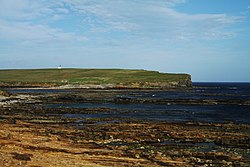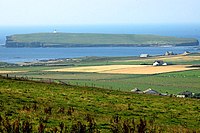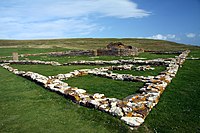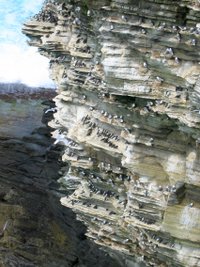Brough of Birsay
| Brough of Birsay | |

| |
|---|---|
| Location | |
| Location: | 59°8’24"N, 3°19’48"W |
| Grid reference: | HY236285 |
| Area: | 40 acres |
| Highest point: | 151 feet |
| Data | |
| Population: | (Uninhabited) |
The Brough of Birsay is an uninhabited tidal island off the northwest coast of The Mainland of Orkney. It is in the parish of Birsay.
Geography and geology
The island is accessible on foot at low tide by a largely natural causeway. It is separated from the mainland by a 787-foot stretch of water at high tide: the Sound of Birsay.[1]
The remains of the Norse settlement on the island hasve been partly removed by coastal erosion, and the cliffs are reinforced by concrete rip-rap to prevent further damage.
History

The earliest settlement on the island is thought to have been in the 5th century, perhaps by Christian missionaries. By the 7th century it was a fortress, and in the 9th century the local people were displaced by Norsemen. Another fort on the northwest of Mainland Orkney is Gurness, a well preserved Pictish broch.
The old settlement, assumed to be Pictish, is attested by a small well and an important collection of artefacts (now in Tankerness House Museum in Kirkwall and in the Museum of Scotland in Edinburgh). Notable among these are a group of moulds for fine metalworking, showing that brooches and other ornaments were being manufactured on the site in the eighth century. The enclosure round the Norse church overlies a Pictish graveyard, and an important Pictish carved stone was found in pieces in this enclosure during site clearance (also on display in Edinburgh: replica on site).
The most interesting pre-Norse remain found is a stone slab showing three figures and some additional symbols. It is not known what the subject of this carving is, but it likely shows aristocratic men as they wished to be perceived. This early eighth century slab shows a striking procession of three men dressed in long robes and bearing spears, swords and square shields. Above the figures are parts of four symbols. Two simple cross-incised slabs, likely grave-markers, were also found in the graveyard, and are probably Pictish or early mediæval in date (displayed on site).

The Old Norse name for the island was "Byrgisey" which means fort island, and gives the parish its name. Brough, indeed, means fort, more familiar as 'broch'. At its east end are extensive remains of an excavated Norse settlement and church. Archaeological investigation has shown that these overlay an earlier pre-Norse settlement. There is a small site museum. The finds of Viking Era are also very rich, forming one of the best collections of such material in the British Isles.
According to the Orkneyinga saga the main residence of Jarl Thorfinn the Mighty (1014-1065) was located in Birsay, possibly on the Brough. At this time the first Bishop of Orkney was appointed and his cathedral was probably on the site of the present day St Magnus Kirk, nearby on the Mainland.

Many of the remains of these settlements are visible. The most significant being the remains of a fine, though small Romanesque church. This dates back to about 1100 and was dedicated to St Peter. It has an interesting shape; probably with a square tower at one end, and a semi-circular apse at the other. There is some evidence of an earlier, possibly Pictish church on the same site. The church was a place of pilgrimage until the Middle Ages. The remains of adjoining buildings round three sides of an open court suggest that it may once have been a small monastery (though there is no documentation for such a foundation).
The site is in the care of Historic Scotland.
Lighthouse
The unmanned Brough of Birsay Lighthouse lighthouse is on the Brough.[2]
Pictures
-
The island is connected with mainland by concrete pathway
-
Cliffs
-
Whole island
Outside links
| ("Wikimedia Commons" has material about Brough of Birsay) |
- Finds from the Brough of Birsay in the Museum of Scotland
References
- ↑ Orkneyjar: Ancient seat of Orkney power. Retrieved 1 August 2007.
- ↑ "Brough of Birsay Lighthouse". Northern Lighthouse Board. http://www.nlb.org.uk/ourlights/history/birsay.htm. Retrieved 5 March 2010.
| Islands of Orkney |
|---|
|
Inhabited islands: |



